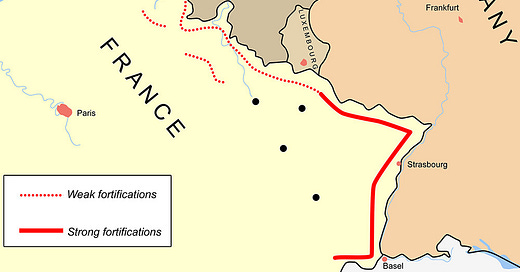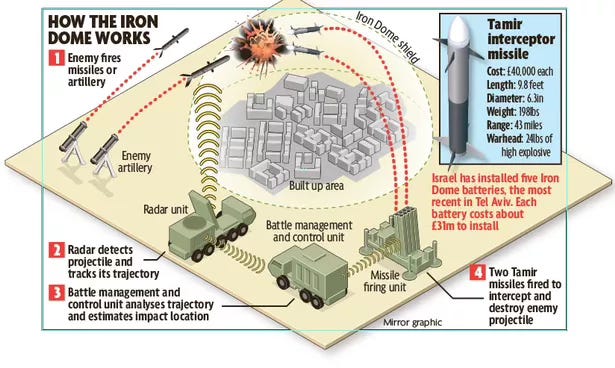This is a reader-supported publication. I give it all away for free but could really use your support if you want me to keep doing this.
Hall of Fame Major League Baseball icon “Wee” Willie Keeler, one of the greatest ever with a bat in terms of efficiency, had this advice for fellow hitters:
Keep your eye clear, and hit 'em where they ain't."
After WWI, France decided to prevent another German invasion by building the most sophisticated and systematic set of defensive borderland forts in the history of the world. Really, only the Great Wall of China compares in both ambition and futility (e.g., The Great Wall was great against the small-fry nomadic tribes but didn’t stop Genghis Khan and his Mongol horde).
Both the Maginot Line and the Great Wall were, much like Trump’s border wall, incomplete and so they could be gotten around. With France, the theory was that, if the Line could deter a direct cross-border invasion from Germany, then the Brits and them would have sufficient time to mount a defense when the Germans came through Belgium. In other words, France wanted Germany to have to invade via Belgium — that was the whole point of the wall. It was hoped that the Ardennes Forest would complicate that vector sufficiently to give the combined UK-French forces enough warning to respond and thus keep the fight in Belgium and not let it into France.
Decent theory but huge bet.
And yeah, if you think Belgium wasn’t so keen on that, you’d be right. But, the alternative of building the Maginot Line all the way to include France’s border with Belgium was considered … you know … a bit much in both cost and signaling (Go ahead and take Belgium, Germany! See if we care!).
What the French didn’t anticipate was Germany’s development of “lightning war” (blitzkrieg — still today practiced in the National Football League, where it is known as blitzing the quarterback by sending more defenders at him than the offense has blockers to protect him).
[And yes, I know you appreciated that bit of historical linking.]
Germany’s blitzkrieg was an offensive ethos of surprise attacks, using combined arms (air, armor, troops, artillery) in a very fast and opportunistic manner (pushing every breakthrough to the max in a very Gen. George Patton way). It was the original “shock and awe” campaign model, and it worked for Germany until they ran into opponents (US in West, Soviet Union in East) capable of massing sufficient force and sustained logistics to negate that approach. We beat Germany because we had more “stuff” (unbelievable amount of platforms generated by our immense industrial capacity) and good troops while the Soviets beat Germany by just being willing to waste troops and ultimately producing a stunning number of tanks and artillery. On average, the German troops were better, as in, more efficient. There was just only so many of them to manage a two-front war (Germany’s repeated mistake from WWI).
The larger lesson remained the same across both wars: don’t get in a fight with opponents who can greatly outproduce you in terms of arms, because, in the end, that’s what wins — mass.
We have structured the US military along such lines ever since, occasionally toying with special efforts to focus on small wars and counter-insurgency (see Vietnam, Iraq) but generally preferring to plan for the Big One and having sufficient material on hand to wage that extended fight — despite the logic of Mutually Assured Destruction in relation to nuclear weapons, which says that such a war between nuclear powers would logically and inevitably and rather quickly escalate to all-out nuclear exchanges — as in, bye bye Earth and let’s relocate the remaining United States to New Zealand.
Over the years, however, America’s military establishment has kept up the dream of missile defense for the nation — recall, Ronald Reagan seeing the movie Star Wars and deciding it would be visionary to militarize space because … that just seemed so cool to be fighting in outer space against an “evil empire,” am I right?
Okay, I kid a bit there on the genesis, but not by much, mind you.
No, we did not plan on putting nukes in orbit. Instead, the Strategic Defense Initiative (SDI) was conceived as a defensive system to protect the US from incoming nuclear missiles by degrading their numbers while they were at the apogee of their near-space journey, accomplishing this by hitting them with space-based lasers, particle beams, and interceptor missiles. The idea was to create a layered missile shield that could destroy enough Soviet ballistic missiles in flight to keep the whole idea of winning with a surprise mass attack just too risky for the Sovs to consider — thus reinforcing MAD, so to speak.
Did we ever really achieve SDI? No. Too hard and too expensive and so we did not militarize space as imagined, thank God.
What we did achieve were modest breakthroughs on interceptor missile systems over the years, leading to such ground-based systems as the Terminal High Altitude Area Defense (THAAD) and the Ground-Based Midcourse Defense (GMD) systems, which are currently in use. And yes, we do sell such defensive systems to allies around the world.
While SDI didn’t exactly lead directly to Israel’s development of its own Iron Dome missile defense shield, the two are related. Besides enshrining the ambition of comprehensive missile defense, SDI’s ambitious research programs laid the groundwork for advancements in radar, sensors, missile guidance, and intercept technology. Many of these technologies matured over the following decades and birthed modern missile defense systems, including Israel’s Iron Dome.
Does Iron Dome work for Israel?
Yes, it does. It’s built to defeat massed missile attacks and it does so rather well, whether it’s Hezbollah doing the strikes or Iran or Hamas or Islamic Jihad. Israel routinely shoots down 75-95% of the missiles.
Did Iron Dome stop the 7 October attack? No, it was basically overwhelmed. Hamas launched close to 4,000 rockets in the first four hours, with over 1,000 fired in just the first 20 minutes. Israel’s Iron Dome systems couldn’t reload fast enough to handle that flood-the-zone tactic, and they quickly ran out of interceptor missiles on hand.
While Hamas kept Israel busy with the missile barrage, it used lots of commercial drones to blind Israel’s security forces by attacking their system of sensors and cameras and local-to-Gaza surveillance systems. That opened the door for the ground assault that really did the bulk of the damage and led to hostage taking.
So, basically, Hamas flooded the missile zone and then went with the hit-‘em-where-they-can’t-see-and-respond-fast-enough tactics to mount their deadly incursion, resulting in the biggest loss of Jewish life since WWII — despite Iron Dome and reflecting some classic asymmetrical warfare.
No, Israel won’t be retiring its Iron Dome anytime soon. It works magnificently for what it is designed to do. It’s just that Israel’s opponent in this instance was willing to do a whole lot of other things as well.
What can we learn from this?
Owning the high-end missile defense realm is great, if you can mass the effort and you only have so much territory to protect (Israel is the size of New Jersey). But, say you do mass that effort and protect that territory (maybe just DC and the rest of America can go fish!) … there are still ways for your opponent to just “go around” your defense and attack through other vectors — like Hamas did to Israel.
If I am China or Russia and I’m going to attack the US homeland to distract it while I conquer Taiwan or grab Poland, there are plenty of nefarious and highly effective ways to deliver that blow and send that signal (back off while I do this or else!) short of launching missile strikes that might very well trigger a massive nuclear exchange. Those nefarious ways mostly involve disabling our critical infrastructure through cyber means.
Still, the problem there is that the US, being so subjected to such non-kinetic attacks, would pretty much have to assume they were a prelude to far worse and direct kinetic missile strikes, so — again, you have the problem of uncontrolled escalation leading to the Big One nobody wants.
A lot of the logic being resurrected by Trump’s announcement that America will build a Golden Dome variant of Israel’s system is similarly flawed. Anybody mounting a missile attack of that volume and sophistication that we’d need an Iron Dome equivalent to counter … well, that would be very hard to distinguish from the imagined start of WWIII. And, if you weren’t interested in starting WWIII, there’d be no reason to mount such an attack. Instead, you could signal through all manner of means that you are seeking some limited outcome (capture of Poland, capture of Taiwan) and then basically dare the US to go-all-the-way over that, which, frankly, we wouldn’t, despite any and all bluster.
Don’t believe me? We’ve seen Russia do the same multiple times after suffering attacks by Ukraine that, in past US estimations, could have easily led to WWIII but did no such thing. So, no, I’m not talking hypotheticals here so much as citing clear and compelling and recent real-world evidence.
Instead, we’d mount a countering effort not unlike how Ukraine and its allies have bogged down Russia in this very costly and highly ineffective invasion effort. At that point, it’s a war of attrition between big Russia and small Ukraine and Putin is just fine with that going on ad infinitum.
But, notice, how, in this conflict, it makes zero sense for Russia to launch lotsa missiles at the US as some sort of back-the-hell-off deterrent. There’s just no point to that.
Yes, we could make the same argument with China over Taiwan, meaning the Chinese attack-scenario must be taken very seriously, even as the fight would logically bog down in similar ways (Indo-Pacom’s vision of a drone hellscape response by the US). There would be no reason for China to directly attack the US unless it was set to go all the way to WWIII. And it would be supremely risky to try and blind the US in such circumstances — at home or even in-theater — and assume you could control (much less dominate) the resulting escalation.
Sure, we may well find out the truth of all those imagined scenarios someday soon with China over Taiwan, but guess what? There ain’t no Golden Dome that will prove decisive in whatever scenarios actually do unfold. It will be completely irrelevant.
So the larger point is this: in none of these superpower scenarios will a Golden Dome be the make-it-or-break-it margin in anybody’s calculations. There is no scenario where China throws a bunch of missiles at the US, we intercept 90% of them, and then China goes Whoa! What were we thinking that would work! Call off the invasion of Taiwan!
It’s just not going to work out like that.
Okay then, MAD still rules in superpower stuff and it’s clear that superpowers have figured out a way to attack non-nuclear states without triggering WWIII dynamics (something the US pioneered in our invasions of Afghanistan and Iraq, then Russia engineered without much fuss in Georgia and Ukraine, and which China may someday do with Taiwan). So, maybe, we need a Golden Dome to stop “rogue” mid-level powers like Iran and North Korea from successfully … doing what exactly?
In the event that NorKo or Iran fire missiles at the US, we would end either or both of them in a heartbeat with a massive strategic response likely to include nukes. And no, neither Russia nor China would risk WWIII in that scenario. They’d just let the beatdown happen because there’d be no point to trying to rescue either state in that instance.
Conversely, do you see any scenario where the US, with its Golden Dome, absorbs such an attack from Iran or North Korea and then simply goes, Whew! Thank God for Golden Dome! Now, we don’t have to counter-attack!
That scenario is NEVER unfolding.
Imagine the counter-factual: NorKo missile-attacks China and China responds with nukes, taking out the regime. Is America going to WWIII to protect NorKo? No, it is not. We’d likewise let that beatdown — even a nuclear one — happen. Say, Ukraine smuggles a nuke into Russia and detonates it, is the US then going to WWIII in response when Russia strikes back commensurately? No, we are not. That would just be Ukraine signing its own death warrant.
Okay then, the Golden Dome seems irrelevant to superpowers doing superpower things overseas and there’s no logic for us spending tons of money on a missile defense system that would somehow obviate our response to such an aggression conducted by the likes of Iran or NorKo.
Would Golden Dome stop a terror attack with nuclear weapons? Well, it’s not like Al-Qaeda is going to spend gazillions and years building up for a one-strike-does-all missile attack on the US. If it got its hands on nukes, it would be far easier to simply smuggle in or deliver that hit through non-strategic means.
My point in running down these scenarios — and we can do this all night long — is that there are no good and compelling and inescapable scenarios that say, oh yeah! Let’s spend gazillions of dollars over decades and this capability will rule the world come … I dunno … 2050?
Come 2050, there will be all sorts of nefarious scenarios to deal with, but none of them will be seriously dented by having built a Golden Dome that is highly likely to only work so well, and cover so much of our territory and no more, and be a supremely wasteful and ineffective use of resources between now and then.
Yes, you can counter with the Trumpian hallucination that this system can be deployed by the end of the Great Man’s second term.
To that counter, I say, pass the bong and let me suck a hit off that amazing weed you’re smoking because that is utter fantasy. And I’m not just citing the estimated cost of $500B-plus (CBO). Yes, we can line up a bunch of systems across the country and point them all toward the horizon and declare it a Golden Dome, but that emperor will be wearing a golden thong at best, fooling nobody.
This is just another case of the usual suspects in the defense community snapping to attention and barking yes sir! when given a nutso job that many such true believers are eager to pursue (just like with Reagan’s Star Wars) — all because Trump has “seen the future” in Israel’s Iron Dome and imagines the same capacity makes sense or is even feasible for the US.
It does not make sense. It is not practically feasible in any comprehensively safe-guarding manner. And, if pursued, it will be easily countered by any opponent looking to fuck us up at the right moment for the right reasons.
Remember when Al-Qaeda struck on 9/11 and our entire Defense Department was almost completely irrelevant to the immediate response of kill that man and everyone associated with him(!)?
There are always such workarounds.
The world is leaving behind these notions of military power and moving toward new paradigms. And no, the addition of AI will not somehow re-establish the logic of great-power — much less superpower — warfare as imagined by WWIII scenarios. The Military Singularity is knocking on our door, daring us to adjust to a post-human battlespace.
We will fight and compete with other great and super powers in a host of ways, but none of them will be answerable to, or deterred by, some Golden Dome boondoggle.












Okay, as often happens the Maginot story generates confusion, but it does remain relevant to the conversation. The complete concept was to build the Maginot line fortifications which could then be manned by fewer troops than would have been required if there were no such fortifications. The manpower thus saved would be combined with the field armies that would then fight in the traditional invasion areas as the Germans came (as expected) through Belgium and Holland (and Luxembourg). The problem was that having spent so much money on the Maginot Line fortifications and faced with a depression, the French governments of the day failed to create the field armies and given them the numbers and capabilities that would be necessary to fight the invading German armies in the open. Additionally, much of the French High Command (veterans of the 'victorious' French armies of the Great War, calculated that the next war would be pretty much like the last war - especially the 1918 part - so that's what they trained, equipped, and practiced for. Not all of the French missed the signs about modern mechanized warfare and Charles DeGaulle even wrote a pretty good book about how mechanized armies would be equipped and how they would fight. "Hurrying" Heinz Guderian would even read that book, which was widely printed and sold in Germany, before he sat down to write his own book and eventually German army doctrine for mechanized warfare. So Guderian in 1940 is commanding a Corps while DeGaulle will only get to command a newly formed, incompletely equipped light armored division late in the campaign.
I suggest that Golden Dome is Lockheed's consolation prize for what Elon wants to do their current Golden Goose of F-35 that has been laying shareholder dividends for 19 years since the F-35A first flight. Boeing got their consolation prize(s), LM gets theirs. Fairness (spreading the largesse). The physics hasn't changed much since the 80s. That's 1680's, Isaac Newton, but certainly the 1980's produced a mountain of https://fas.org/ articles showing the math, physics, and cost of BMD. Your statement of the game theory logic is impeccable as usual. And as this admin hasn't produced an original idea yet, sure, use Ron's masterpiece. Ron had Caspar Weinberger, Don has..... Major Warrior Ethos.